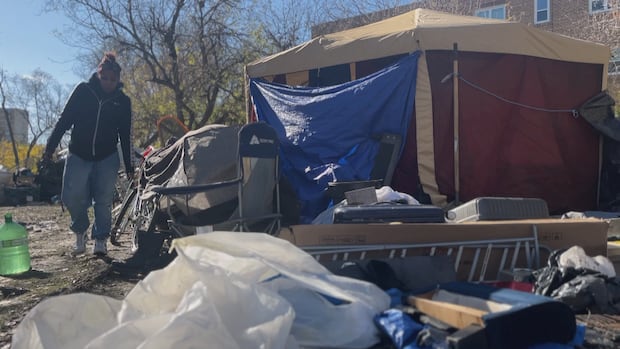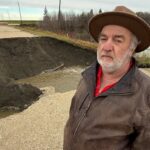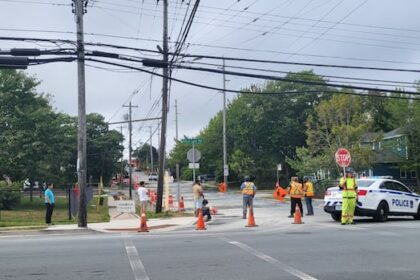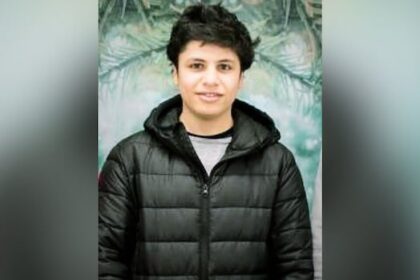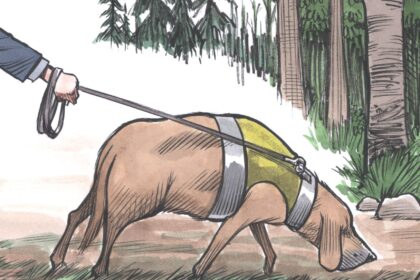Manitoba·NewNew rules restricting where tent encampments can be set up come into effect Nov. 17. CBC News mapped out those areas to show how the new restrictions could change the landscape of encampments in Winnipeg.Map shows which areas of the city will fall under encampment restrictions this monthCameron MacLean · CBC News · Posted: Nov 03, 2025 6:00 AM EST | Last Updated: 28 minutes agoListen to this articleEstimated 5 minutesJanine Desjarlais, who lives in an encampment in Mostyn Park, says she will simply move farther down the riverbank if the city’s new restrictions on encampments force her out. (Victoria Ptashnick/CBC)Winnipeg is about to put new limits on where people who are homeless can sleep outdoors —restrictions that could change the face of encampments across the city.As of Nov. 17, people will no longer be allowed to set up tents within 50 metres of playgrounds, splash pads, pools or daycares, or within 30 metres of transit stops, bridges and docks. The city’s rules come as the number of homeless people and encampments in Winnipeg has increased dramatically in recent years, with a point-in-time street census last year estimating about 2,500 people were experiencing homelessness in the city — the highest number since the surveys began in 2015. That number includes people who were in homeless shelters, living in public spaces like a bus shelter or encampment, and those who were “provisionally accommodated,” which can include people couch-surfing or living in hotels or motels.Using data from the provincial homelessness strategy, the city estimates that as of August this year, there were about 100 encampments across Winnipeg, with as many as 700 people. To show what the city’s new restrictions could mean for those encampments, CBC Manitoba mapped the buffer zones using the criteria council approved. Much of the core area, including long stretches of riverbank and green space where tents are common, falls inside those no-go areas.At an encampment tucked behind the Granite Curling Club in Mostyn Park, tents sit among the trees near the Assiniboine River. The area, in the West Broadway neighbourhood and just a few hundred metres west of the Manitoba Legislature, is near a daycare and the curling club itself — locations that could be off-limits under the new rules, depending on how the city measures distance. Exactly how those buffers will be measured is one of several details still being worked out.That uncertainty hangs over Janine Desjarlais, who has lived there since early summer.”I’m not moving. What for?” she said. “I’m not doing nothing to no one. I don’t know what the problem is. It’s not like they’re out here every day, all day long.”Desjarlais says she’s been trying to get into housing, but rarely hears back when she tries. If she’s forced to leave, she expects she’ll simply move farther down the riverbank.Lucien Baron, who also lives in the Mostyn Park encampment, says he supports the city’s restrictions, because he worries about the safety of kids like his eight-year-old daughter. (Victoria Ptashnick/CBC)In the same camp, Lucien Baron says he supports keeping encampments away from playgrounds, because he worries about the safety of children around camps. He has an eight-year-old daughter.”I’m glad they’re enforcing it,” he said. “I wouldn’t bring my daughter down here.… Some kid’s gonna pick up a needle and stick himself and get HIV or, like, an overdose, and that’s going to be it — tents gonna be shut down everywhere.”In the apartment building next to the park, resident Billy Jaye says he’s dealt with thefts and vandalism since tents went up nearby. He pointed to a section of fence where someone cut through to access the apartment building’s parking lot.He says he wants to feel compassion for those living outside, but he has also had four bikes stolen. Earlier this year, Jaye’s neighbour had to stamp out a small fire lit outside his door.”I don’t want to be all NIMBY about it — not in my backyard,” Jaye said. “I want to feel for these people, [but] not at the expense of you’re robbing me.”Billy Jaye lives in an apartment building next to the Mostyn Park camp. He says he has dealt with thefts, fires and break-ins at his building. (Trevor Brine/CBC)Jaye doubts the new rules will make much difference. Rather, he says the winter weather will drive people away.Greg MacPherson, the city’s acting manager of community development, wrote the city’s policy. He said it will evolve over time.”We haven’t done this before, so it is a work in progress,” MacPherson said. “We’re approaching it as a living document.”The city plans to review the policy after its first year and report back to council on what worked — and what didn’t.Mayor Scott Gillingham says enforcement will begin with outreach, before moving to clear people out.”To say to those who are living in a tent, for example, in a park, ‘You can’t be there. Let’s get you the help you need. Let’s get you into either a shelter or …. connected with housing’ — that’s the goal,” he said. “The hard enforcement, I think, will be very few and far between.”The city has been told to proceed without additional funding, using existing staff, including two bylaw officers and one co-ordinator dedicated to the file.Displacement not a solution: councillorNot everyone at city hall supports the approach.Fort Rouge-East Fort Garry Coun. Sherri Rollins — whose ward includes the Mostyn Park area — says the rules may simply push people from one place to another.”You can see that migration … whether along the Assiniboine [River], or they’ve now moved behind every single business in Osborne Village,” Rollins said. “It isn’t housing people. It’s just making very vulnerable people have to work all day to move their belongings somewhere else.”She also worries the city’s small enforcement team will struggle to handle the workload.Janine Desjarlais says she wants to get housing, but doesn’t have the money to do so. (Victoria Ptashnick/CBC)For Desjarlais at the Mostyn Park encampment, the policy leaves a lot of uncertainty. As temperatures drop, she’s focused on staying warm and safe.”They should just think about it,” she said. “Stop being so self-centred, just because they have everything. A lot of people don’t have the funds to get out of here.”WATCH | Winnipeg’s new rules for encampments could reshape where they go:What Winnipeg’s new rules mean for people in, and near, encampmentsThe city’s new restrictions on homeless encampments will limit where people can live in tents, potentially changing the landscape of encampments in core-area communities. But questions remain about whether the rules will simply push encampments into other parts of the city. ABOUT THE AUTHORCameron MacLean is a journalist for CBC Manitoba living in Winnipeg, where he was born and raised. He has more than a decade of experience reporting in the city and across Manitoba, covering a wide range of topics, including courts, politics, housing, arts, health and breaking news. Email story tips to cameron.maclean@cbc.ca.With files from Victoria Ptashnick
Monday, 22 Dec 2025
Canada – The Illusion
Search
Have an existing account?
Sign In
© 2022 Foxiz News Network. Ruby Design Company. All Rights Reserved.
You May also Like
- More News:
- history
- Standing Bear Network
- John Gonzalez
- ᐊᔭᐦᑊ ayahp — It happened
- Creation
- Beneath the Water
- Olympic gold medal
- Jim Thorpe
- type O blood
- the bringer of life
- Raven
- Wás’agi
- NoiseCat
- 'Sugarcane'
- The rivers still sing
- ᑲᓂᐸᐏᐟ ᒪᐢᑿ
- ᐅᑳᐤ okâw — We remember
- ᐊᓂᓈᐯᐃᐧᐣ aninâpêwin — Truth
- This is what it means to be human.
- Nokoma


